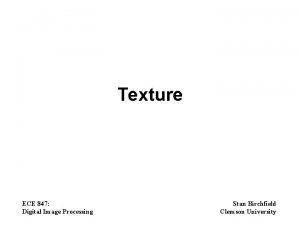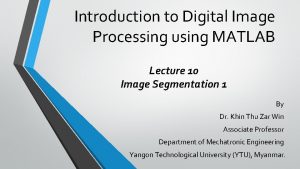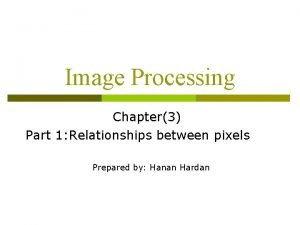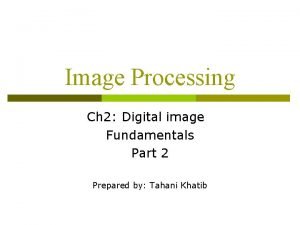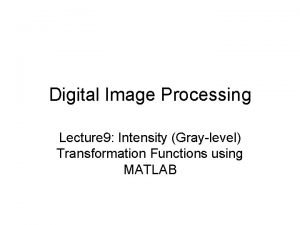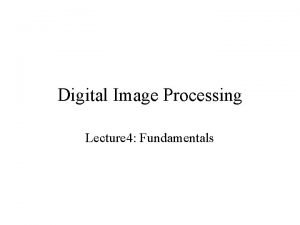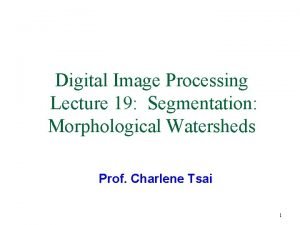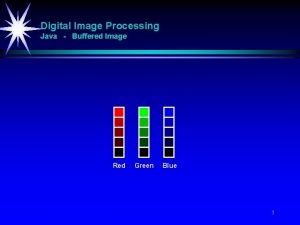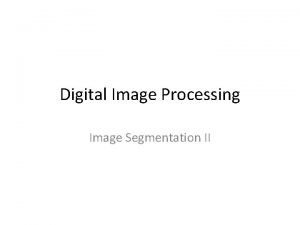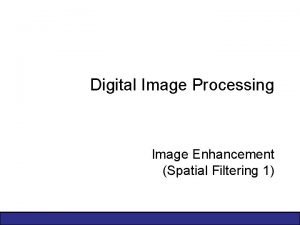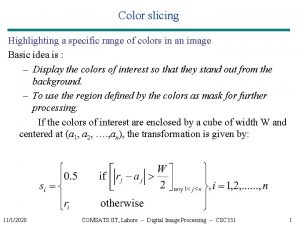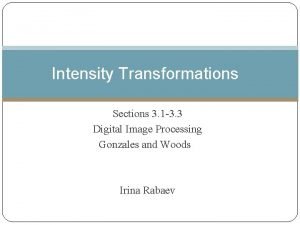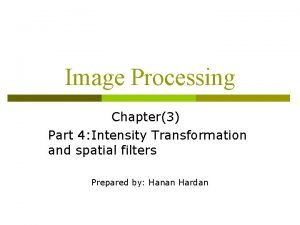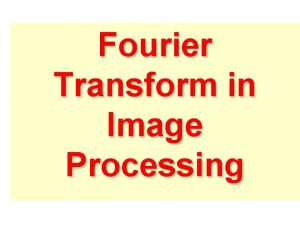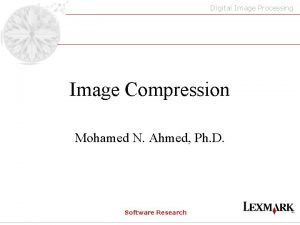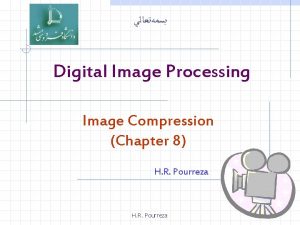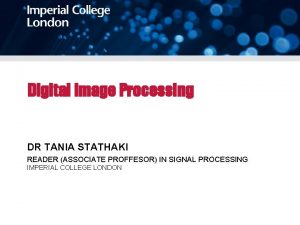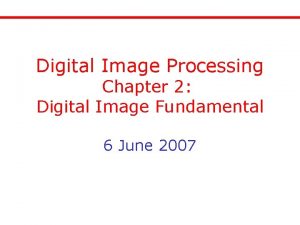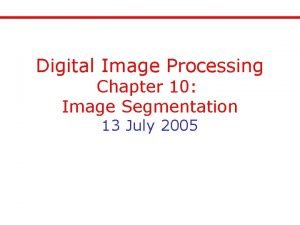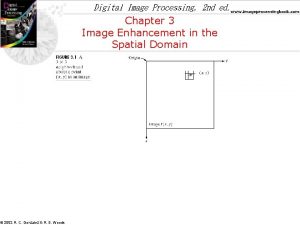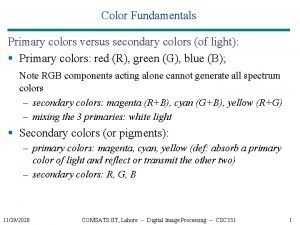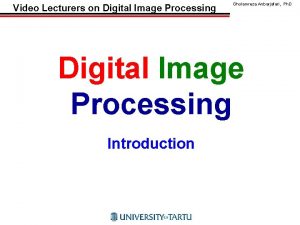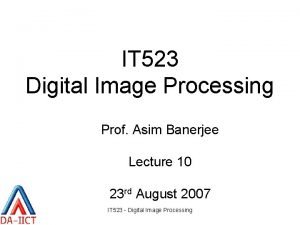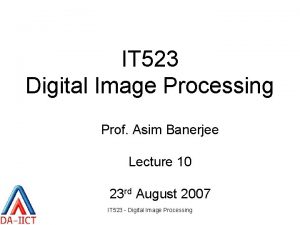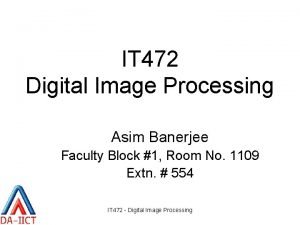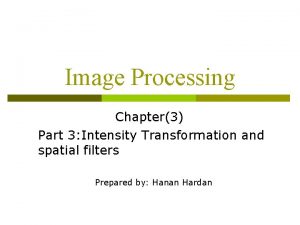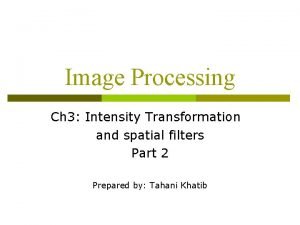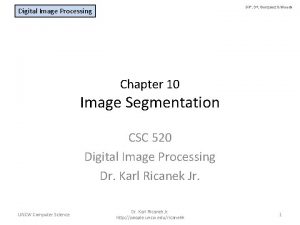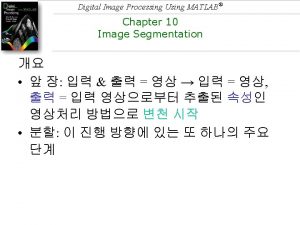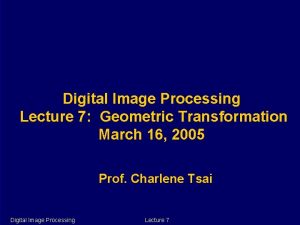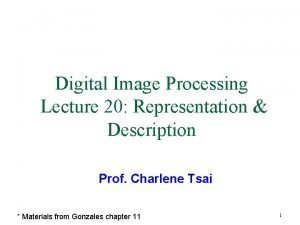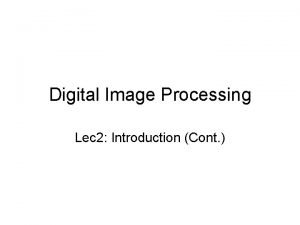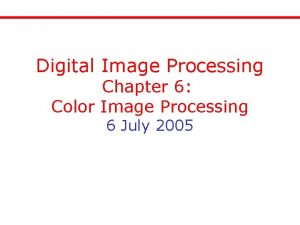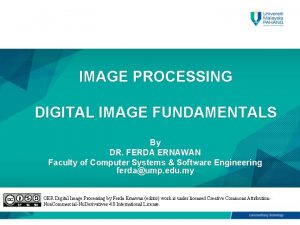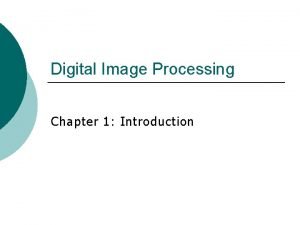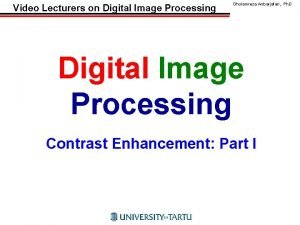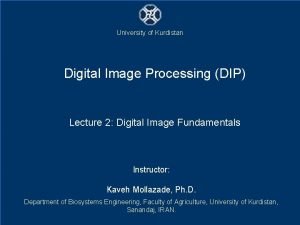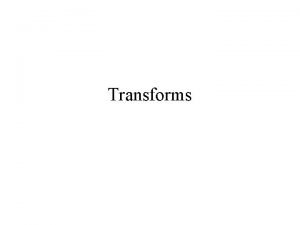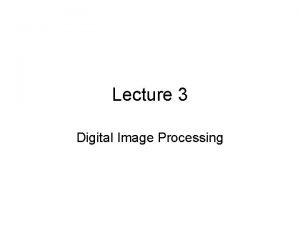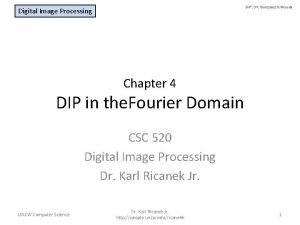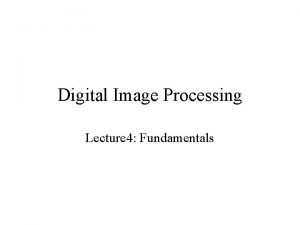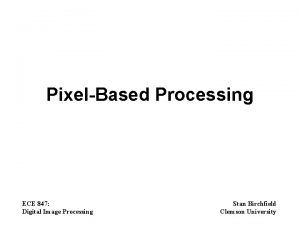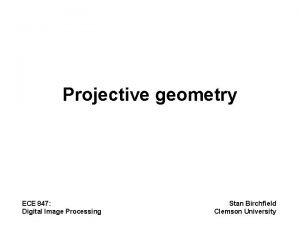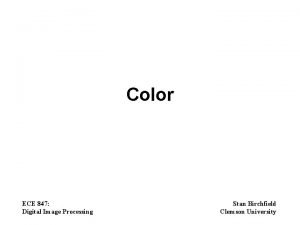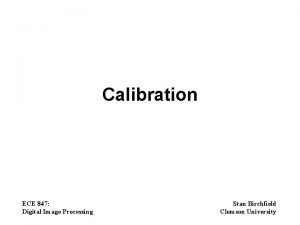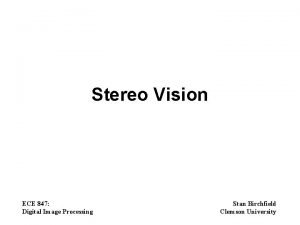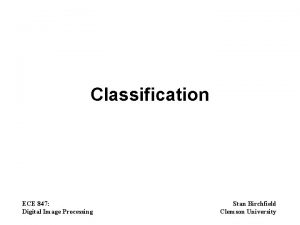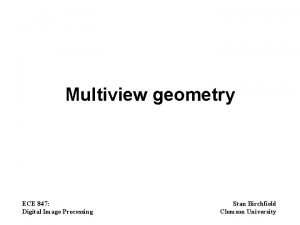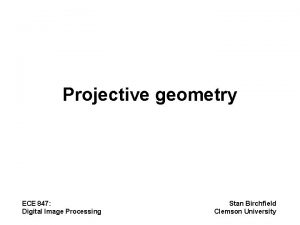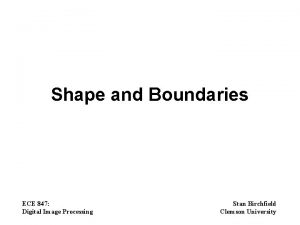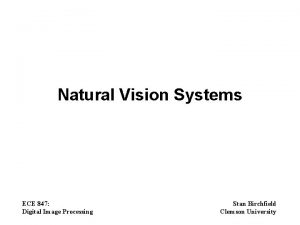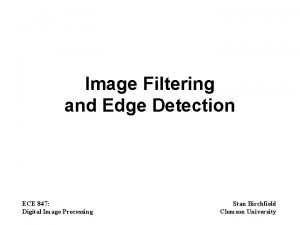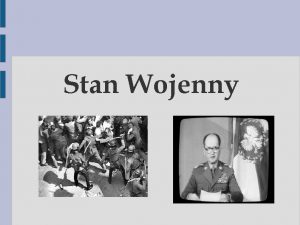Image formation ECE 847 Digital Image Processing Stan














































































- Slides: 78

Image formation ECE 847: Digital Image Processing Stan Birchfield Clemson University

Cameras • First photograph due to Niepce • Basic abstraction is the pinhole camera – lenses required to ensure image is not too dark – various other abstractions can be applied F. Dellaert, http: //www. cc. gatech. edu/~dellaert/vision/html/materials. html

Image formation overview Image formation involves • geometry – path traveled by light • radiometry – optical energy flow • photometry – effectiveness of light to produce “brightness” sensation in human visual system • colorimetry – physical specifications of light stimuli that produce given color sensation • sensors – converting photons to digital form

Pinhole camera D. Forsyth, http: //luthuli. cs. uiuc. edu/~daf/bookpages/slides. html

Parallel lines meet: vanishing point • each set of parallel lines (=direction) meets at a different point – The vanishing point for this direction • Sets of parallel lines on the same plane lead to collinear vanishing points. – The line is called the horizon for that plane

Perspective projection Properties of projection: • Points go to points • Lines go to lines • Planes go to whole image • Polygons go to polygons • Degenerate cases k P – line through focal point to point – plane through focal point to line C f O j p q i Q F. Dellaert, http: //www. cc. gatech. edu/~dellaert/vision/html/materials. html

Perspective projection (cont. ) F. Dellaert, http: //www. cc. gatech. edu/~dellaert/vision/html/materials. html

Weak perspective projection • perspective effects, but not over the scale of individual objects • collect points into a group at about the same depth, then divide each point by the depth of its group D. Forsyth, http: //luthuli. cs. uiuc. edu/~daf/bookpages/slides. html

Weak perspective (cont. ) F. Dellaert, http: //www. cc. gatech. edu/~dellaert/vision/html/materials. html

Orthographic projection Let Z 0=1: F. Dellaert, http: //www. cc. gatech. edu/~dellaert/vision/html/materials. html

Pushbroom cameras

Pinhole size Pinhole too big many directions are averaged, blurring the image Pinhole too smalldiffraction effects blur the image Generally, pinhole cameras are dark, because a very small set of rays from a particular point hits the screen. D. Forsyth, http: //luthuli. cs. uiuc. edu/~daf/bookpages/slides. html

The reason for lenses D. Forsyth, http: //luthuli. cs. uiuc. edu/~daf/bookpages/slides. html

The thin lens focal points D. Forsyth, http: //luthuli. cs. uiuc. edu/~daf/bookpages/slides. html

Focusing http: //www. theimagingsource. com

Thick lens • thick lens has 6 cardinal points: – two focal points (F 1 and F 2) – two principal points (H 1 and H 2) – two nodal points (N 1 and N 2) • complex lens is formed by combining individual concave and convex lenses http: //physics. tamuk. edu/~suson/html/4323/thick. html D. Forsyth, http: //luthuli. cs. uiuc. edu/~daf/bookpages/slides. html

Complex lens All but the simplest cameras contain lenses which are actually composed of several lens elements http: //www. cambridgeincolour. com/tutorials/camera-lenses. htm

Choosing a lens • How to select focal length: – x=f. X/Z – f=x. Z/X • Lens format should be >= CCD format to avoid optical flaws at the rim of the lens http: //www. theimagingsource. com/en/resources/whitepapers/download/choosinglenswp. en. pdf

Lenses – Practical issues • standardized lens mount has two varieties: – C mount – CS mount • CS mount lenses cannot be used with C mount cameras http: //www. theimagingsource. com/en/resources/whitepapers/download/choosinglenswp. en. pdf

Spherical aberration perfect lens actual lens On a real lens, even parallel rays are not focused perfectly http: //en. wikipedia. org/wiki/Spherical_aberration

Chromatic aberration On a real lens, different wavelengths are not focused the same http: //en. wikipedia. org/wiki/Chromatic_aberration

Radial distortion straight lines are curved: uncorrected

Radial distortion (cont. ) Two types: barrel distortion pincushion distortion (more common) barrel pincushion http: //en. wikipedia. org/wiki/Image_distortion http: //foto. hut. fi/opetus/260/luennot/11/atkinson_6 -11_radial_distortion_zoom_lenses. jpg

Vignetting vignetting – reduction of brightness at periphery of image D. Forsyth, http: //luthuli. cs. uiuc. edu/~daf/bookpages/slides. html

Normalized Image coordinates 1 O u=X/Z = dimensionless ! P F. Dellaert, http: //www. cc. gatech. edu/~dellaert/vision/html/materials. html

Pixel units Pixels are on a grid of a certain dimension f O u=k f X/Z = in pixels ! P [f] = m (in meters) [k] = pixels/m F. Dellaert, http: //www. cc. gatech. edu/~dellaert/vision/html/materials. html

Pixel coordinates We put the pixel coordinate origin on topleft f O u=u 0 + k f X/Z P F. Dellaert, http: //www. cc. gatech. edu/~dellaert/vision/html/materials. html

Pixel coordinates in 2 D (0. 5, 0. 5) 480 640 (u 0, v 0) i (640. 5, 480. 5) j F. Dellaert, http: //www. cc. gatech. edu/~dellaert/vision/html/materials. html

Summary: Intrinsic Calibration skew 5 Degrees of Freedom ! F. Dellaert, http: //www. cc. gatech. edu/~dellaert/vision/html/materials. html

Camera Pose In order to apply the camera model, objects in the scene must be expressed in camera coordinates. Camera Coordinates World Coordinates Calibration target looks tilted from camera viewpoint. This can be explained as a difference in coordinate systems. F. Dellaert, http: //www. cc. gatech. edu/~dellaert/vision/html/materials. html

Rigid Body Transformations • Need a way to specify the six degrees-of-freedom of a rigid body. • Why are there 6 DOF? A rigid body is a collection of points whose positions relative to each other can’t change Fix one point, three DOF Fix second point, two more DOF (must maintain distance constraint) Third point adds one more DOF, for rotation around line F. Dellaert, http: //www. cc. gatech. edu/~dellaert/vision/html/materials. html

Notations • Superscript references coordinate frame • AP is coordinates of P in frame A • BP is coordinates of P in frame B • Example: F. Dellaert, http: //www. cc. gatech. edu/~dellaert/vision/html/materials. html

Translation F. Dellaert, http: //www. cc. gatech. edu/~dellaert/vision/html/materials. html

Translation • Using homogeneous coordinates, translation can be expressed as a matrix multiplication. • Translation is commutative F. Dellaert, http: //www. cc. gatech. edu/~dellaert/vision/html/materials. html

Rotation means describing frame A in The coordinate system of frame B F. Dellaert, http: //www. cc. gatech. edu/~dellaert/vision/html/materials. html

Rotation Orthogonal matrix! F. Dellaert, http: //www. cc. gatech. edu/~dellaert/vision/html/materials. html

Example: Rotation about z axis What is the rotation matrix? F. Dellaert, http: //www. cc. gatech. edu/~dellaert/vision/html/materials. html

Rotation in homogeneous coordinates • Using homogeneous coordinates, rotation can be expressed as a matrix multiplication. • Rotation is not commutative F. Dellaert, http: //www. cc. gatech. edu/~dellaert/vision/html/materials. html

Rigid transformations F. Dellaert, http: //www. cc. gatech. edu/~dellaert/vision/html/materials. html

Rigid transformations (con’t) • Unified treatment using homogeneous coordinates. F. Dellaert, http: //www. cc. gatech. edu/~dellaert/vision/html/materials. html

Projective Camera Matrix 5+6 DOF = 11 ! F. Dellaert, http: //www. cc. gatech. edu/~dellaert/vision/html/materials. html

Projective Camera Matrix 5+6 DOF = 11 ! F. Dellaert, http: //www. cc. gatech. edu/~dellaert/vision/html/materials. html

Columns & Rows of M m 2 P=0 O F. Dellaert, http: //www. cc. gatech. edu/~dellaert/vision/html/materials. html

Effect of Illumination (Subject 8 from the Yale face database due to P. Belhumeur et. al. ) Light source strength and direction has a dramatic impact on distribution of brightness in the image (e. g. shadows, highlights, etc. ) F. Dellaert, http: //www. cc. gatech. edu/~dellaert/vision/html/materials. html

Image formation • Light source emits photons • Absorbed, transmitted, scattered • fluorescence source Camera F. Dellaert, http: //www. cc. gatech. edu/~dellaert/vision/html/materials. html

Surfaces receives and emits • Incident light from lightfield • Act as a light source • How much light ? F. Dellaert, http: //www. cc. gatech. edu/~dellaert/vision/html/materials. html

Irradiance • Irradiance – amount of light falling on a surface patch • symbol=E, units = W/m 2 d. A F. Dellaert, http: //www. cc. gatech. edu/~dellaert/vision/html/materials. html

Radiosity • power leaving a point per area • symbol=B, units = W/m 2 d. A F. Dellaert, http: //www. cc. gatech. edu/~dellaert/vision/html/materials. html

Light = Directional • Light emitted varies w. direction F. Dellaert, http: //www. cc. gatech. edu/~dellaert/vision/html/materials. html

Steradians (Solid Angle) • 3 D analogue of 2 D angle A R F. Dellaert, http: //www. cc. gatech. edu/~dellaert/vision/html/materials. html

Steradians (cont’d) F. Dellaert, http: //www. cc. gatech. edu/~dellaert/vision/html/materials. html

Polar Coordinates F. Dellaert, http: //www. cc. gatech. edu/~dellaert/vision/html/materials. html

Intensity • Intensity – amount of light emitted from a point per steradian • symbol=I, units = W/sr F. Dellaert, http: //www. cc. gatech. edu/~dellaert/vision/html/materials. html

Irradiance and Intensity d. A F. Dellaert, http: //www. cc. gatech. edu/~dellaert/vision/html/materials. html

Radiance • Radiance – amount of light passing through an area d. A and • symbol=L, units = W x m-2 x sr-1 F. Dellaert, http: //www. cc. gatech. edu/~dellaert/vision/html/materials. html

Radiance is important • Response of camera/eye is proportional to radiance • Pixel values • Constant along a ray F. Dellaert, http: //www. cc. gatech. edu/~dellaert/vision/html/materials. html

Lightfield = Gibson optic array ! • 5 DOF: Position = 3 DOF, 2 DOF for direction F. Dellaert, http: //www. cc. gatech. edu/~dellaert/vision/html/materials. html

Lightfield Sampler F. Dellaert, http: //www. cc. gatech. edu/~dellaert/vision/html/materials. html

Lightfield Sample F. Dellaert, http: //www. cc. gatech. edu/~dellaert/vision/html/materials. html

Lambertian Emitters • • Lambertian = constant radiance More photons emitted straight up Oblique: see fewer photons, but area looks smaller Same brightness ! Total power is proportional to wedge area “Cosine law” Sun approximates Lambertian: Different angle, same brightness • Moon should be less bright at edges, as gets less light from sun. • Reflects more light at grazing angles than a Lambertian reflector F. Dellaert, http: //www. cc. gatech. edu/~dellaert/vision/html/materials. html

Radiance Emitted/Reflected • Radiance – amount of light emitted from a surface patch per steradian per area • foreshortened ! d. A F. Dellaert, http: //www. cc. gatech. edu/~dellaert/vision/html/materials. html

Calculating Radiosity If reflected light is not dependent on angle, then can integrate over angle: radiosity is an approximate radiometric unit F. Dellaert, http: //www. cc. gatech. edu/~dellaert/vision/html/materials. html

Example: Sun • • Power= 3. 91 1026 W Surface Area: 6. 07 1018 m 2 Power = Radiance. Area. L = 2. 05 107 W/m 2. sr Example from P. Dutre SIGGRAPH tutorial F. Dellaert, http: //www. cc. gatech. edu/~dellaert/vision/html/materials. html

Irradiance (again) • Integrate incoming radiance over hemisphere F. Dellaert, http: //www. cc. gatech. edu/~dellaert/vision/html/materials. html

Example: Sun F. Dellaert, http: //www. cc. gatech. edu/~dellaert/vision/html/materials. html

BRDF E L Symmetric in incoming and outgoing directions – this is the Helmholtz reciprocity principle F. Dellaert, http: //www. cc. gatech. edu/~dellaert/vision/html/materials. html

BRDF Example F. Dellaert, http: //www. cc. gatech. edu/~dellaert/vision/html/materials. html

Lambertian surfaces and albedo • For some surfaces, the DHR is independent of illumination direction too – cotton cloth, carpets, matte paper, matte paints, etc. • For such surfaces, radiance leaving the surface is independent of angle • Called Lambertian surfaces (same Lambert) or ideal diffuse surfaces • Use radiosity as a unit to describe light leaving the surface • DHR is often called diffuse reflectance, or albedo • for a Lambertian surface, BRDF is independent of angle, too. • Useful fact: F. Dellaert, http: //www. cc. gatech. edu/~dellaert/vision/html/materials. html

Specular surfaces • Another important class of surfaces is specular, or mirror-like. – radiation arriving along a direction leaves along the specular direction – reflect about normal – some fraction is absorbed, some reflected – on real surfaces, energy usually goes into a lobe of directions – can write a BRDF, but requires the use of funny functions F. Dellaert, http: //www. cc. gatech. edu/~dellaert/vision/html/materials. html

Lambertian + specular • Widespread model – all surfaces are Lambertian plus specular component • Advantages – easy to manipulate – very often quite close true • Disadvantages – some surfaces are not • e. g. underside of CD’s, feathers of many birds, blue spots on many marine crustaceans and fish, most rough surfaces, oil films (skin!), wet surfaces – Generally, very little advantage in modelling behaviour of light at a surface in more detail -- it is quite difficult to understand behaviour of L+S surfaces F. Dellaert, http: //www. cc. gatech. edu/~dellaert/vision/html/materials. html

Radiometry vs. Photometry http: //www. optics. arizona. edu/Palmer/rpfaq. htm F. Dellaert, http: //www. cc. gatech. edu/~dellaert/vision/html/materials. html

Sensors • CCD vs. CMOS • Types of CCDs: linear, interline, fullframe, frame-transfer • Bayer filters • progressive scan vs. interlacing • NTSC vs. PAL vs. SECAM • framegrabbers • blooming F. Dellaert, http: //www. cc. gatech. edu/~dellaert/vision/html/materials. html

Bayer color filter http: //en. wikipedia. org/wiki/Bayer_filter

Adobe’s plenoptic lens captures multiple views of the scene from slightly different viewpoints David Salesin and Todor Georgiev F. Dellaert, http: //www. cc. gatech. edu/~dellaert/vision/html/materials. html

Raw image from plenoptic system http: //livesmooth. istreamplanet. com/nvidia 100921/

Reconstructed image

Change the focus

Lenticular display http: //en. wikipedia. org/wiki/Lenticular_printing
 Zooming and shrinking in digital image processing
Zooming and shrinking in digital image processing Histogram processing in digital image processing
Histogram processing in digital image processing Neighborhood processing
Neighborhood processing Laplacian filter
Laplacian filter Point processing in image processing
Point processing in image processing Point processing in digital image processing
Point processing in digital image processing Gonzalez
Gonzalez Image processing and analysis birchfield pdf
Image processing and analysis birchfield pdf 8476851447
8476851447 Translate
Translate Optimum notch filter in digital image processing
Optimum notch filter in digital image processing Image compression models in digital image processing
Image compression models in digital image processing Key stage in digital image processing
Key stage in digital image processing Lossless image compression matlab source code
Lossless image compression matlab source code Image sharpening and restoration
Image sharpening and restoration Geometric transformation in digital image processing
Geometric transformation in digital image processing Image transforms in digital image processing
Image transforms in digital image processing Maketform matlab
Maketform matlab Image restoration in digital image processing
Image restoration in digital image processing Perspective projection
Perspective projection Explain various boundary descriptors
Explain various boundary descriptors Representation and description in digital image processing
Representation and description in digital image processing Image thresholding matlab
Image thresholding matlab Segmentation in digital image processing
Segmentation in digital image processing Pixel relationship in digital image processing
Pixel relationship in digital image processing Intensity transformation and spatial filtering
Intensity transformation and spatial filtering Zooming and shrinking in digital image processing
Zooming and shrinking in digital image processing Imadjust
Imadjust Mixed adjacency in image processing
Mixed adjacency in image processing Coordinate conventions in digital image processing
Coordinate conventions in digital image processing Dam construction in digital image processing
Dam construction in digital image processing Digital image processing java
Digital image processing java Thresholding in digital image processing
Thresholding in digital image processing Segmentation in digital image processing
Segmentation in digital image processing Spatial filtering in digital image processing
Spatial filtering in digital image processing Representation and description in digital image processing
Representation and description in digital image processing Optimum global thresholding using otsu's method
Optimum global thresholding using otsu's method What is boundary descriptors in digital image processing
What is boundary descriptors in digital image processing Color slicing in image processing
Color slicing in image processing Let h and i be the size and intensity of the image
Let h and i be the size and intensity of the image Intensity transformation and spatial filtering
Intensity transformation and spatial filtering Fourier transform in image processing
Fourier transform in image processing Digital image processing
Digital image processing Digital image processing
Digital image processing Kl transform in digital image processing
Kl transform in digital image processing Digital image processing
Digital image processing Jpeg in digital image processing
Jpeg in digital image processing Digital image processing
Digital image processing Mach band effect in digital image processing
Mach band effect in digital image processing Filetype:ppt
Filetype:ppt Digital image processing
Digital image processing Color fundamentals in digital image processing
Color fundamentals in digital image processing Image processing
Image processing Digital path in image processing
Digital path in image processing Digital path in image processing
Digital path in image processing Lossless compression in digital image processing
Lossless compression in digital image processing Intensity level slicing matlab
Intensity level slicing matlab Intensity transformation in digital image processing
Intensity transformation in digital image processing Digital image processing
Digital image processing Houghpeaks matlab
Houghpeaks matlab Fluorocein
Fluorocein For a chain code 10103322
For a chain code 10103322 Fundamental steps in digital image processing
Fundamental steps in digital image processing Digital image processing
Digital image processing Full colour image processing
Full colour image processing Spatial resolution in digital image processing
Spatial resolution in digital image processing Digital image processing
Digital image processing Image processing
Image processing Color transformation in digital image processing
Color transformation in digital image processing Origins of digital image processing
Origins of digital image processing Pattern and pattern classes in image processing
Pattern and pattern classes in image processing Raquel anido
Raquel anido Digital image processing
Digital image processing Hadamard transform in digital image processing
Hadamard transform in digital image processing Aliasing in image processing
Aliasing in image processing Shape numbers in digital image processing
Shape numbers in digital image processing Digital processing
Digital processing Image processing
Image processing Coordinate conventions in digital image processing
Coordinate conventions in digital image processing







